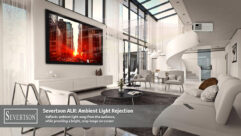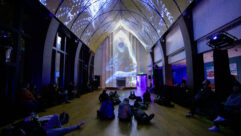Ambient Light May Reduce Eyestrain for Television Viewers
May 15, 2006 8:00 AM
In the wake of an announcement last spring that it would recall 11,800 plasma TVs sold between June 2005 and January 2006 due to faulty parts, Philips has reaffirmed its commitment to the Ambilight technology with the introduction of six new models for the coming year. The nearly 12,000 TVs in question included a faulty capacitor that had the potential to cause arcing in the sets. Philips reported nine cases of sparking—but no resulting fires—when it made the recall announcement in March.
The company will ship six new Ambilight models this summer between June and August, including three plasmas and three LCD models. On a product tour in New York last week, Philips flat TV marketing manager Jonathan Wight said LCD remains the flagship flat-panel technology for the company, with plasma models filling Philips’ “technology-agnostic” role for customers who prefer that technology. At a retail price of $2,499, Philips’ new 42in. Ambilight LCD model carries a $500 premium over its 42in. plasma counterpart.
The company touts the ClearLCD display technology in the two new 42in. LCDs as a premium engineering feature that addresses two of the caveats of LCD TV performance: motion artifacts and reduced contrast compared with plasma and CRT. The company claims ClearLCD technology significantly boosts black level, provides a wider viewing angle, and reduces blurring artifacts in sports and other fast-action scenes over conventional LCD designs.
The six new Ambilight TVs due out this summer are the third generation of Philips’ Ambilight series. In Ambilight systems, Philips’ color analysis software identifies the dominant colors on the screen and blends ambient light with the dominant light to extend the consumer’s viewing field. The light uses the wall behind the TV as a reflecting surface. The company maintains that the backlighting reduces eye strain, and gives viewers a perceived improvement in picture detail, contrast and color.
New this year is Ambilight Full Surround (not to be confused with audio surround), a four-sided Ambilight system that’s said to provide a more immersive experience for the viewer. A single Full Surround model, the 42in. 42 PF9831 LCD TV ($3,999) will ship in August, packing the palette of Philips proprietary features including Ambilight Full Surround, ClearLCD, and Pixel Plus 3HD. The top-of-the-line model is designed for homeowners who don’t have the recommended cream-colored wall as a background for the TV—or who have another surface such as glass or wood which aren’t optimum for reflecting Ambilight colors. The set comes with its own off-white back panel that frames the display.
Three models in the lineup incorporate first-generation “two-channel” Ambilight design with light emitting from behind the left and right sides of the TV. Those models include a 37in. LCD ($2,299, June) and a 50in. plasma ($3,499, June). Three-sided Ambilights (with light diffusers at the left, right and top of the screen) include a 42in. LCD ($2,999, July) and 50in. plasma ($3,999, July).
Since the introduction of Ambilight, Philips has used SMPTE (Society of Motion Picture Television Engineers) recommendations to reinforce the idea that ambient light reduces eye fatigue during television viewing. SMPTE recommends that the optimum level of ambient light surrounding a television should be less than 10 percent of the peak white output in order to minimize eye strain for the viewer.
A study published last month by the Lighting Research Center at the Rensselaer Polytechnic Institute (and funded by Philips Innovative Applications) supports that theory. According to John Bullough, lead researcher of the TV study, “Eyestrain can occur when the eyes are fixed on an object for a long period of time, there is poor lighting, or there is glare.” He says watching TV in a dark room can create physical discomfort caused by the large contrast in luminance between the TV screen and the dark background.”
In the study, subjects watched one hour of action movie footage on a Philips Ambilight flat-screen TV and one hour with illumination turned off. Before and after viewing, subjects had to respond to visual cues while researchers monitored electrical brain activity, including blink rates. Researchers also questioned and observed participants to evaluate impact of surrounding illumination on subjective responses.
Researchers said the effects were modest, but measurable. Interestingly, the subjective responses—rather than objective measurements—were most supportive of the study’s conclusion. “Only subjective ratings of difficulty focusing, and of sleepiness, and the reduction in the duration between the stimulus onset and an electrophysiological brain response showed statistically significant differences between the two conditions,” according to Yukio Akashi, senior research specialist at LRC.










